Mycelium Image Decay
A term being entered in the box below, images will be loaded from the Internet via Google, which then serve the mycelium for “food”. In its growth the mycelium follows the structures of the images and makes them fleetingly visible before they are decomposed and composted. The mycelium generates a continuous process which leaves our perception to alternate between abstract patterns, familiar signs, and iconic forms.
Exhibition / Video
Mycelium: Serpula lacrymans

Serpula lacrymans in nutrient solution (top left) and in petri dish, 2002
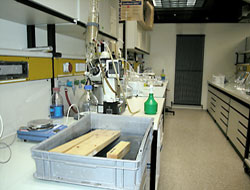
Incubation of spruce wood with Serpula lacrymans, 2002
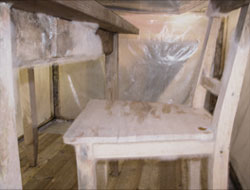
Thomas Feuerstein, One and No Chair (right)
Thomas Feuerstein, Desk Philipp Mainländer (left)
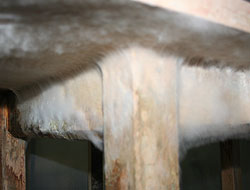
Desk Philipp Mainländer, Serpula lacrymans, mycelium on spruce wood, 2003
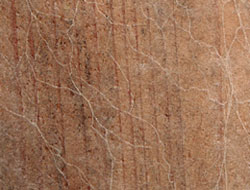
Desk Philipp Mainländer, Serpula lacrymans, mycelium on spruce wood, 2004
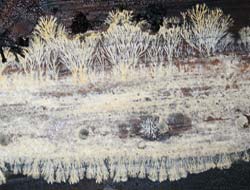
Desk Philipp Mainländer, Serpula lacrymans, mycelium on spruce wood, 2005
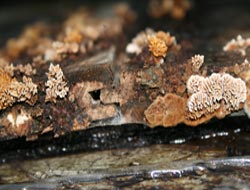
Desk Philipp Mainländer, Serpula lacrymans, fruiting body on spruce wood, 2006

The Aesthetics of Entropy
According to the law of entropy[1] every establishment of order will happen at the expense of an increase of disorder. Information, matter and energy are subject to wear and tear, to disintegration and to decay. From the state of being they progress to the state of non-being.
Civilisation and culture may be defined as a struggle against entropy and they aim for the creation of values. The bigger the exertions to contain devaluation and dissolution, the stronger and the more rapid the entropic effects will be. The higher the banks of morality, technology, and of economic accumulation of capital, the more devastating the destructions looming.
Classic aesthetics are dedicated to the perception and the generating of orders, proportions and structures. Quite in contrast, the aesthetics of entropy deal with the transitoriness of information and matter. It does not follow negentropy but “negontology”. Its object of investigation is the dissolution of things and of being.
Networks of Entropy
Biology distinguishes between producers and destruents. The latter include fungi breaking down and decomposing organic material. In analogy to the information networks, the mycelium of the fungi forms networks of entropy. The most extensive myceliums are brought forth by the honey mushroom (Armillaria ostoyae) that, e.g. in Oregon, can pervade an area of several square kilometres and, with a biomass of about 600 tons, constitutes the largest living organism on Earth.
The Melancholy of Entropy
The so-called dry rot or Serpula lacrymans that, due to the droplets forming on its hyphae, was given the Latin name “the tearful fungus”, decomposes wood by breaking down the cellulose. Starting out from damp basement rooms its mycelium, often undetectedly, grows through walls and spreads throughout ceiling joists and roof beams of houses. Once the fungus, on its search for new food, becomes visible on the surface of walls, the building's fabric is extensively damaged and at times there is an acute danger of collapse.[2]
Serpula lacrymans is regarded as a cultural pest that damages architecture and furniture. In this light it acts as a catalyst of entropy, as a radical individual interrupting and destroying values of civilisation.
One and No Chair
The title of the work One and No Chair refers to the installation One and Three Chairs by Joseph Koshut. Koshut's work illustrates a passage from Plato's The Republic[3] and investigates the relations between language, image and referent. The work One and No Chair, on the other hand, starts out from a cultural artefact and an informed piece of matter that is being broken down and decomposed by Serpula lacrymans. The focus, though, is not on the idea or the information of the chair, but on the process of dematerialisation. The chair, containing within itself the possibility of not being a chair anymore, becomes a transitional object of decay. It refers to a universal logic of life and eludes the categorical orders of classic philosophy - possession, identity and ontology being subjected to a composting.
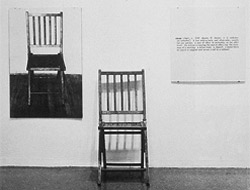
Joseph Koshut, One and Three Chairs,
1965. Chair, photograph, text
Desk Philipp Mainländer
In the two volumes of his work The Philosopy of Redemption Philipp Mainländer (1841 - 1876) developed a metaphysics of entropy. Based on the reading of Schopenhauer, and his aphoristic speech on life being but a mould covering the surface of the planet, Mainländer postulates a will that cannot be influenced and that, from the very beginning, is directed towards attrition and decay. The whole cosmos moves from the state of being towards the state of non-being. Life and all its creative potential are means to the end of bringing abrasion and attrition about even sooner and to reach the state of non-being. Mainländer's philosophy does not resist the loss of being, it does not go in search of timeless values, but instead thinks to its end the cadaverisation of the world in which moral dualisms of good and evil have to disappear. It accepts the entropic flow of all that exists and sweeps aside all conservatisms and retarding moments in order to pave the way for the free flow of decomposition.
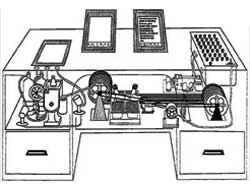
An illustration of the Memex by Vannevar Bush,
LIFE Magazine, 1945
In general desks are regarded as places where battles are fought against entropy. They are sites for the production of texts and culture and symbolise the work place of the author manipulating symbols and generating information. Since the emergence of information technologies the symbol worker and the desk, virtualised through the metaphor of the electronic desktop, have come to merge. A paradigmatic example, in this context, is Vannevar Bush's Memex (Memory Extender), a machine shaped like a desk that was to combine electro-magnetic control units and microfilm devices. The concept of this fictitious analogue computer as “an enlarged appendix to memory” anticipated hypertext structures and mycelium-like data networks. In the spirit of the metaphysics of entropy the work Desk Philipp Mainländer reverses this principle and transforms the Memory Extender into an Entropy Extender.
The Parasite: The Pathology of a Metaphor
We are no everyday persons and we have
to pay dearly for eating at the
table of the gods.
Philipp Mainländer
One and No Chair and Desk Philipp Mainländer are preparing the ground for a parasitic fungus. Although serpula lacrymans grows on dead organisms and in mycological parlance is called a saprophyte, it constitutes an exemplary information parasite in the context of the two works that, as an anthropophilous species, devours furniture and causes whole buildings to collapse.
In ancient times the term parasite (Greek pará-sitos: to eat beside, with another person; Latin parasitus: a fellow diner) applied to a respected religious official who takes in the ritual sacrificial meal together with the priests and gods. Simultaneously parasites appear as worldly entertainers who, comparable to the role of the artist, the poet and the intellectual of Western salon culture, through their presence endowed stately banquets with a social feel.
The decline of the term parasite to mean a “workshy, happy-go-lucky person” begins with Greek comedy where it is used to describe persons living at the cost of others. In this sense the term then is borrowed from Latin in the late Middle Ages.
The term found its way into the natural sciences when Sir Thomas Browne describes mistletoes as “parasitical plants” in 1646. With the epidemics of the 18th and 19th centuries parasites enter medical awareness and become a universal synonym for all kinds of illnesses. They are thought to cause pox, measles, scarlet fever, typhus, influenza, dysentery, cholera or the Black Death.
Charged with connotations of visceral worms and epidemics the term was again applied to humans and denoted ostensibly “defective persons” disrupting the social and cultural symmetry. Johann Gottfried Herder, for instance, declared Jews a “parasitic growth on the stem of other nations”, and when the Christian Social Party was founded in Germany in 1878, on which occasion modern anti-semitism raised its ugly head, the “Jewish parasite” was finally created. Since then the term parasite has served to describe social problems and to designate “pests on the body social”. Politics have become a “medical” discipline that cleanses and heals the national body from “social parasites”.
The metaphorical use of the term parasite returns into philosophy with Michel Serres (Le parasite, 1980); and with Richard Dawkins and his idea of the “selfish gene” (1976), using humans as vehicles for perpetuating information, it returns into biology. In 1982 Nature magazine published a widely discussed article by Francis H. C. Crick, co-discoverer of DNA, and L. E. Orgel entitled “Selfish DNA: the Ultimate Parasite” in which each part of the DNA not producing proteins is defined as “junk”.
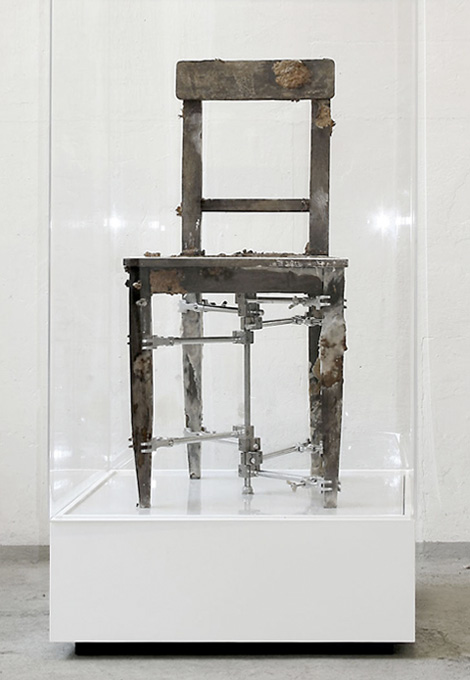
Thomas Feuerstein, One and No Chair, 2002 - 2008. Timber, Serpula lacrymans, plexiglass, stainless steel, aluminium, 170 x 65 x 65 cm. Courtesy Galerie Elisabeth & Klaus Thoman.
[1] The term entropy (Greek entrepein: to turn around) in 1865 was introduced by Rudolf Clausius (1822 - 1888) to describe the reversibility of a thermodynamic process. Since energy is lost, though, during the reversal, the law of entropy, in the spirit of the Second Law of Thermodynamics, postulates that matter and energy can change only in one direction, from an ordered to a non-ordered state.
[2] The fungus is described as early as the Book of Moses (14, 13 - 55).
[3] Plato, The Republic, 597b: “Well then, here are three chairs: one existing in nature (…) There is another which is the work of the carpenter? (…) And the work of the painter is a third?”










